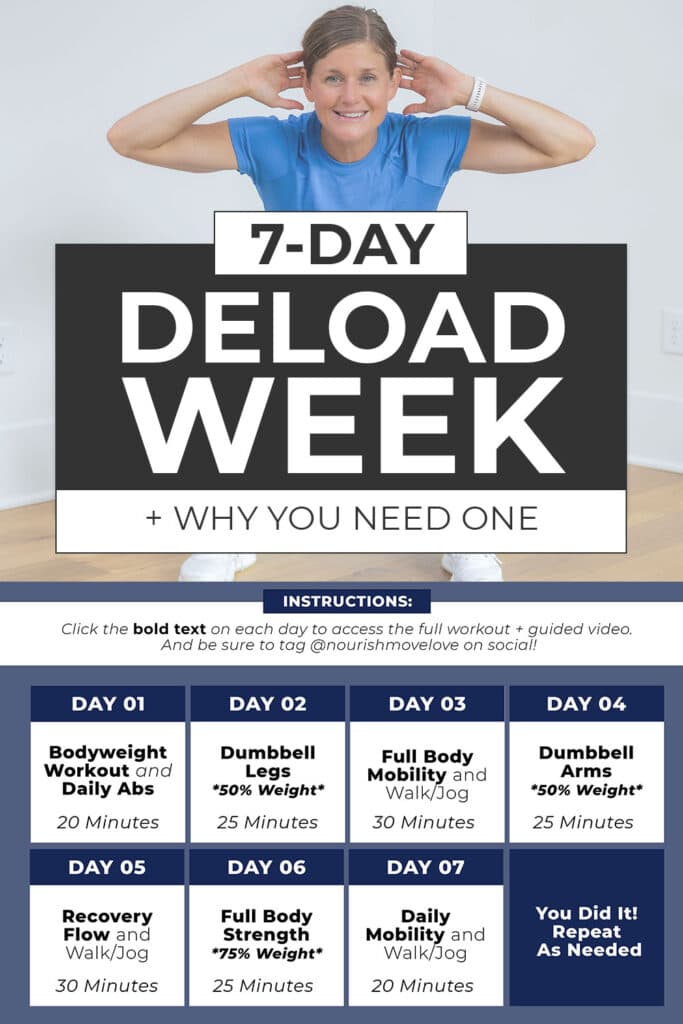

7-Day Deload Week (Workout Plan PDF)
Overcome fitness plateaus, increase workout motivation and reduce risk of overtraining and injury by adding a deload week to your training routine. Deload weeks are intentional periods of reducing workout intensity and focusing on rest and recovery. These temporary breaks allow your body time to recover and adapt, leading to improved athletic performance and muscle growth.

LET’S GET STARTED
Download Your FREE Deload Week Plan Here
After over a decade in the fitness industry, I’ve finally shifted my mindset to working out smarter, not harder.
This means I focus on lifting heavier during my strength training workouts, eating 30 grams of protein at every meal, and taking rest and recovery seriously through daily mobility and regular “deload” weeks.
A deload week is an intentional period of cutting back on your workout intensity in order to come back stronger.
If you struggle with persistent muscle soreness, aches and pains, trouble sleeping, a lack of workout motivation or decreased strength and endurance during your training sessions, it’s time to take a deload week.
A deload week is a crucial part of any effective training program. However, this doesn’t just mean a week of total inactivity.
Deload weeks work by reducing daily workout intensity and training volume (by reducing number of sets or weight used) and adding in additional active recovery activities, such as walking, swimming and stretching.
Here’s the seven-day deload week plan I follow to optimize my strength gains, prevent overtraining and reduce risk of injury.

Deload Week (7-Day Plan)
Day 1: 10-Minute Full Body Workout and 10-Minute Daily Abs
- YouTube Links: 10-Minute Morning Workout and 10-Minute Daily Ab Workout
- Workout Time: 20 Minutes
- Equipment: No Equipment
Day 2: 25-Minute Dumbbell Leg Workout
- YouTube Link: 25-Minute Dumbbell Leg Workout (Strength Training)
- Workout Time: 25 Minutes
- Equipment: Dumbbells (50% of your usual weight. For example, if I typically use 20 lb dumbbells, I would use 10 lb dumbbells for this workout).
Day 3: 15-Minute Mobility and Light Walk or Jog
- YouTube Link: 15-Minute Mobility Routine
- Workout Time: 15 Minutes, plus walk/jog (~30 minutes total)
- Equipment: No Equipment
- Walk/Jog Alternative: Sub this 15-Minute Cardio Workout (Get 2,000 Steps)
Day 4: 25-Minute Dumbbell Arm Workout
- YouTube Link: 25-Minute Dumbbell Arm Workout (Strength Training)
- Workout Time: 25 Minutes
- Equipment: Dumbbells (50% of your usual weight. For example, if I typically use 20 lb dumbbells, I would use 10 lb dumbbells for this workout).
Day 5: 10-Minute Recovery Flow and Light Walk or Jog
- YouTube Link: 10-Minute Active Recovery Yoga Flow
- Workout Time: 10 Minutes, plus walk/jog (~30 minutes total)
- Equipment: No Equipment
- Walk/Jog Alternative: Sub this 15-Minute Standing Cardio (Get 1,500 Steps)
Day 6: 25-Minute Single Dumbbell Workout
Day 7: 5-Minute Daily Mobility and Light Walk or Jog

Find This Workout Plan On Youtube
Deload Details
1. Gym Equipment Needed:
Dumbbells. There are three strength workouts programmed into this deload week plan. You’ll want to use lighter weights than you would typically reach for (between 50-75% of your typical weights). You may want a yoga mat (discount code: NourishMoveLove) or cushion for exercises performed from your back.
2. Time Requirement:
20-30 Minutes/Day. Option to add additional rest days as needed.
3. Fitness Level:
Beginner to advanced. Modifications are offered for all fitness levels in the daily workout videos.
4. Cost:
FREE! No sign up needed.
Follow This Deload Week With A Workout Plan
After completing your deload week, it’s time to jump into a new training plan. Here are some of our most popular:
- Strong 20 is a functional strength training program designed to help you build strength for the demands of everyday life.
- Stronger 25 is the progression of the Strong 20 program, adding more complex movements, core training and balance work into each workout.
- SplitStrong 35 is a strength-focused split training workout routine. SplitStrong is designed to build a solid base of foundational strength.
- Build 30 is a muscle-building strength program, with short bursts of cardio/endurance training built into each workout.
- HIITStrong 35 is the HIIT version of SplitStrong. HIITStrong adds some additional intensity and advanced compound exercises to the strength base you built in SplitStrong.
- MetCon 100 is a high-intensity metabolic conditioning program, designed to push you mentally and physically. Each workout includes a 100 rep challenge to leave you feeling strong and accomplished.
- Zero 30 is a no equipment full body, body weight workout program designed to be done ANYWHERE.
Deload Week FAQs
A deload week is an intentional period of scaling down your workouts by reducing intensity, load or duration. This can help both the muscles and the nervous system recover from the natural fatigue caused by exercise.
Listen to your body. If you’re feeling run down, regularly dealing with delayed onset muscle soreness (DOMS), or feel a lack of motivation around exercising, it’s time to deload. Most people will benefit from adding a deload week every 8-12 weeks.
A deload week is different from a rest week. During your deload week, you want to continue training, but reduce your intensity. This can look like working out fewer days per week, using lighter weights, or performing fewer repetitions. Additionally, focus on adding in forms of active recovery, such as yoga, walking, swimming and cycling.
How To Download and Use This Workout Plan
- Download the Deload Week PDF by clicking here, or bookmark this webpage for reference as weekly workouts are outlined below.
- Save this workout calendar to your mobile device home screen for easy access.
- Open this workout calendar pdf in the safari browser on your phone.
- Tap the bottom arrow in the center of your screen.
- Select ‘Add to Home Screen’.
- Hover over and then click on the bold text each day to access the full video on Youtube. Or scroll down to find the daily workouts linked below.
- You can also access all of the home workout videos on this workout challenge calendar on YouTube via this YouTube Playlist: Deload Week (7-Day Plan).
- Share your daily workouts with me by tagging @nourishmovelove on social and ‘Pin’ the daily workouts on Pinterest so you can do them again.
Pin this Free Deload Week PDF

Note: before beginning any new exercise program you should consult with your physician or midwife. The information provided with this workout challenge is intended for general information and use; it does not include specific, individualized recommendations and is not intended as medical advice. Before you begin any new exercise program Nourish Move Love recommends that you consult with your physician. Nourish Move Love primarily educates clients to assume more personal responsibility for their health by adopting a healthy and active lifestyle.
This post does include affiliate links and I earn a small commission on products purchased using these links. All words and opinions are my own. Thank you for supporting Nourish Move Love.



















I am so glad we are doing this program this week! I loved the Build program. My arms are looking good…but my shoulder sockets needed a break, phew! Keep up the great content. Love you guys!
Hi Amie! I am so glad you loved the Build 30 Program and are now enjoying the deload week. It’s always good to pull back a bit so you can come back stronger after a bit of rest. Thanks for following along! -Lindsey